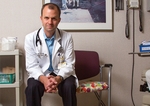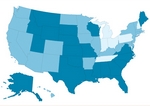Profession
Military sweetens the deal to entice medical students
■ A beefed-up scholarship program now offers a $20,000 signing bonus as well as full tuition and an increased monthly stipend.
By Myrle Croasdale — Posted July 7, 2008
- WITH THIS STORY:
- » Recruiting military doctors
- » Related content
Katie Doyle could have borrowed $200,000 to get through medical school. Instead, when she enters Nova Southeastern University College of Osteopathic Medicine in Fort Lauderdale, Fla., this fall, she won't borrow a dime.
Doyle accepted a military scholarship that will pay her tuition, books and other school fees. A monthly stipend will cover living expenses. The scholarship, called the Health Professions Scholarship Program, or HPSP, also comes with a new $20,000 signing bonus.
In exchange, Doyle will serve four years as an Army physician when she completes her medical training.
Medical student enlistment in the armed services through the HPSP has dropped in recent years, but military leaders now hope to turn that situation around.
The Navy began offering the signing bonus in June 2007, followed by the Army in February and the Air Force in April. Military officials believe the $20,000 bonus will encourage other medical students to commit to becoming military physicians.
The scholarship, offered by all three military branches, covers tuition at any U.S. medical school plus school-related fees for textbooks and lab equipment. In exchange, students take officer training during medical school breaks, do a military residency and then practice in the military for four years.
"The HPSP is our primary pipeline for bringing physicians into active duty," said Sandra Yerkes, MD, director of the Navy's HPSP and a retired captain.
It's a mechanism the military can't afford to see falter, with the program supplying 80% to 90% of military physicians, officials said. The recent downturn is most evident in the Navy and Army, which saw steep declines in medical student recruitment in 2005. The Air Force, which historically has exceeded its recruiting goals, saw its first slip in 2007.
In response, Congress authorized the three branches to bolster their recruitment packages, resulting in the $20,000 bonus, along with a $300 hike in the scholarship's monthly stipend, which is now $1,900. The money comes from military appropriations earmarked for medical corps recruitment. In 2007, the Air Force recruited 211 medical school students; the Army, 242; and the Navy, which also recruits for the Marines, 181.
Dr. Yerkes said it's not clear why medical student recruitment is down. It could be this generation of students is less debt-averse. More women are entering medical school, and women are less interested in military service than men.
Students are more likely to enlist if they had a relative in the military, and this is the first generation where students haven't had a parent who served during a world war, Dr. Yerkes said. Conflicts in the Middle East could be a deterrent, said Lt. Col. Curt Prichard, Air Force Recruiting Service officer accessions chief.
"There is no doubt these are challenging times with the war in Iraq and Afghanistan," he said. "The entire global war on terror has challenged the will of Americans and potential applicants."
Strategic changes
Col. Rafael Montagno, Army Medical Recruiting Brigade commander, said there was a time when the Army did not do much recruiting for the HPSP, but that's no longer the case.
Rather than wait for applicants to come to them, ad campaigns and face-to-face recruiting are now regular activities for Army medical recruiters. Internet chat rooms, hosted by military physicians and residents, are another avenue for promoting the scholarship, particularly to those already in medical school.
In the Seattle, Wash., area, recruiters take potential applicants on a tour of the Madigan Army Medical Center and set up a panel of physicians to talk about what it's like to be a military doctor.
"It opens up the eyes of a lot of our students who aren't familiar with what the military life is all about," Col. Montagno said.
If applications continue at their current pace, he added, the Army should surpass the number of students recruited last year.
Dr. Yerkes of the Navy said the signing bonus sparked an initial flurry of Navy applicants, followed by a lull she expects will end as students get their medical school acceptance letters. The Air Force said it's too soon to judge the bonus' impact for 2008.
For recruit Doyle, the signing bonus was the tipping point. But it helped that her grandfather was an Army pediatrician and that she had a friend in nursing school on an Army scholarship.
Still, it was hard to grasp the ramifications of her commitment. "It's eight years away," she said of her military service. "I hope we're not still at war then, but somebody has to take care of people who get injured. It scares me a little bit, but not enough to make me not want to do it."












